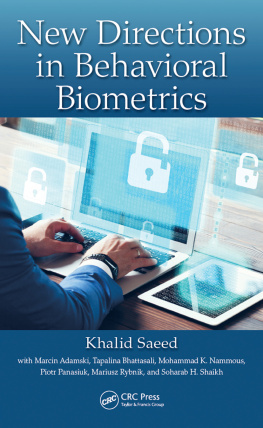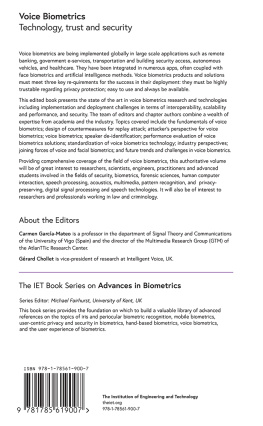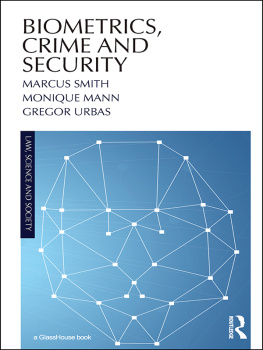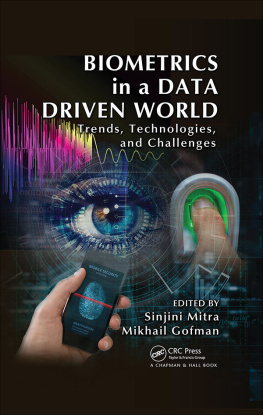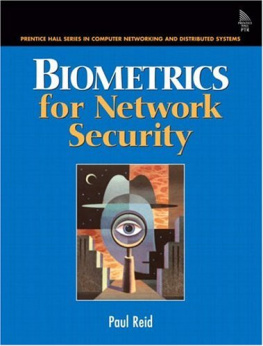Saeed - New Directions in Behavioral Biometrics
Here you can read online Saeed - New Directions in Behavioral Biometrics full text of the book (entire story) in english for free. Download pdf and epub, get meaning, cover and reviews about this ebook. City: Boca Raton;FL, year: 2017, publisher: CRC Press, genre: Computer. Description of the work, (preface) as well as reviews are available. Best literature library LitArk.com created for fans of good reading and offers a wide selection of genres:
Romance novel
Science fiction
Adventure
Detective
Science
History
Home and family
Prose
Art
Politics
Computer
Non-fiction
Religion
Business
Children
Humor
Choose a favorite category and find really read worthwhile books. Enjoy immersion in the world of imagination, feel the emotions of the characters or learn something new for yourself, make an fascinating discovery.
New Directions in Behavioral Biometrics: summary, description and annotation
We offer to read an annotation, description, summary or preface (depends on what the author of the book "New Directions in Behavioral Biometrics" wrote himself). If you haven't found the necessary information about the book — write in the comments, we will try to find it.
Saeed: author's other books
Who wrote New Directions in Behavioral Biometrics? Find out the surname, the name of the author of the book and a list of all author's works by series.
New Directions in Behavioral Biometrics — read online for free the complete book (whole text) full work
Below is the text of the book, divided by pages. System saving the place of the last page read, allows you to conveniently read the book "New Directions in Behavioral Biometrics" online for free, without having to search again every time where you left off. Put a bookmark, and you can go to the page where you finished reading at any time.
Font size:
Interval:
Bookmark:

New Directions in Behavioral Biometrics
New Directions in Behavioral Biometrics
Khalid Saeed
with Marcin Adamski, Tapalina Bhattasali, Mohammad K. Nammous, Piotr Panasiuk, Mariusz Rybnik, and Soharab H. Shaikh

CRC Press
Taylor & Francis Group
6000 Broken Sound Parkway NW, Suite 300
Boca Raton, FL 33487-2742
2017 by Taylor & Francis Group, LLC
CRC Press is an imprint of Taylor & Francis Group, an Informa business
No claim to original U.S. Government works
Printed on acid-free paper
Version Date: 20160531
International Standard Book Number-13: 978-1-4987-8462-7 (Hardback)
This book contains information obtained from authentic and highly regarded sources. Reasonable efforts have been made to publish reliable data and information, but the author and publisher cannot assume responsibility for the validity of all materials or the consequences of their use. The authors and publishers have attempted to trace the copyright holders of all material reproduced in this publication and apologize to copyright holders if permission to publish in this form has not been obtained. If any copyright material has not been acknowledged please write and let us know so we may rectify in any future reprint.
Except as permitted under U.S. Copyright Law, no part of this book may be reprinted, reproduced, transmitted, or utilized in any form by any electronic, mechanical, or other means, now known or hereafter invented, including photocopying, microfilming, and recording, or in any information storage or retrieval system, without written permission from the publishers.
For permission to photocopy or use material electronically from this work, please access www.copyright.com (http://www.copyright.com/) or contact the Copyright Clearance Center, Inc. (CCC), 222 Rosewood Drive, Danvers, MA 01923, 978-750-8400. CCC is a not-for-profit organization that provides licenses and registration for a variety of users. For organizations that have been granted a photocopy license by the CCC, a separate system of payment has been arranged.
Trademark Notice: Product or corporate names may be trademarks or registered trademarks, and are used only for identification and explanation without intent to infringe.
Library of Congress Cataloging-in-Publication Data
Names: Saeed, Khalid (Computer scientist), author.
Title: New directions in behavioral biometrics / Khalid Saeed with Marcin Adamski, Tapalina Bhattasali, Mohammad K. Nammous, Piotr Panasiuk, Mariusz Rybnik, and Soharab H. Shaikh.
Description: Boca Raton : CRC Press, Taylor & Francis Group, 2017. | Includes bibliographical references and index.
Identifiers: LCCN 2016016651 | ISBN 9781498784627
Subjects: LCSH: Biometric identification. | Behaviorism (Psychology)
Classification: LCC TK7882.B56 S236 2017 | DDC 006.2/48--dc23
LC record available at https://lccn.loc.gov/2016016651
Visit the Taylor & Francis Web site at
http://www.taylorandfrancis.com
and the CRC Press Web site at
http://www.crcpress.com
To my assistants and coauthors who have always proved smart, outstanding, and prominent.
Contents
I met Professor Saeed, the principal author of this book, for the first time in 2009 at AGH University of Science and Technology, Krakw, Poland. I was invited as one of the keynote speakers and a researcher of behavioral biometrics in the International Multi-Conference on Biometrics and Kansei Engineering. My first impression of him was a true professor in an elegant suit, with high-quality speech, passionate approach to research, and unfailing kindness. Although 7 years have already passed, his humanity is abiding, and I have ever since constantly communicated with him as a researcher, a university educator, a journal editor, and an international conference chair.
Professor Saeed has achieved a great accomplishment by writing this book: New Directions in Behavioral Biometrics. Publishing this book has been a delightful event for me and many biometrics researchers. Based on the great achievement of his research team, this book includes a readable introduction, beneficial literature reviews, specific approaches, detailed algorithms, and useful experimental results of behavioral biometrics such as signature recognition, keystroke dynamics, gait analysis, and voice recognition.
Biometric technology using physiological characteristics has been widely applied, and many products that employ this technology are very popular, whereas biometric technology using behavioral characteristics has not received considerable attention. However, from a different point of view, research of the behavioral biometrics possesses the possibility of success and advancement. For a university student, a researcher, or a developer who is researching biometrics or developing an application system, this book will provide a clear path of basic information on behavioral biometrics and many hints for new discovery, all coming out of the extensive research experience of the author.
If, in the near future, a technology of identifying an individual based on writing style is developed, Professor Saeed will be easily identified because this book includes his passionate approach and a high degree of completion.
Nobuyuki Nishiuchi
Tokyo Metropolitan University
This book is the result of research conducted with major members of my international biometrics team on some selected topics in behavioral biometrics: a field of study related to the way people behave. As the reader might recall, the science of biometrics deals with biological measurementdescribing and measuring human features for the sake of identity recognition (personal authentication and identification or verification, or both). Biometrics is known in two categories: physiological and behavioral. Physiological biometrics is beyond the scope of this book, but some selected examples have been provided in another book by the author (see Biometrics and Kansei Engineering, Springer, New York, 2012). This book, though, will focus on the most popular and emblematic examples of behavioral biometrics, namely, signature (the way we write), dynamics of keystrokes or touchscreen use (how we use the keyboard or touchscreen to enter text), and gait (how we move our legs to walk). will deal with speech and speaker recognition, that is, the manner and art of combining vocal tracts, tongue, and lips to utter sounds and say words, which is sometimes considered to be a combination of physiological and behavioral features. All these human features are unique; they differ from one person to another, and that is why they can be used to distinguish people.
The content of the book is divided among five chapters. is a general introduction to the subject, showing the nature of each behavioral feature, and discussing how they are collected and prepared for measuring. It also discusses the advantages and disadvantages of using such features for user authentication or personal verification.
These chapters reflect the authors extensive research on the different examples of biometrics. We have published many detailed works and consequently received valuable feedback from the reviewers, readers, and conference participants whenever a research work was presented for discussion. Hence, I hope this book appears in a well-organized and readable form to students and researchers.
Font size:
Interval:
Bookmark:
Similar books «New Directions in Behavioral Biometrics»
Look at similar books to New Directions in Behavioral Biometrics. We have selected literature similar in name and meaning in the hope of providing readers with more options to find new, interesting, not yet read works.
Discussion, reviews of the book New Directions in Behavioral Biometrics and just readers' own opinions. Leave your comments, write what you think about the work, its meaning or the main characters. Specify what exactly you liked and what you didn't like, and why you think so.

